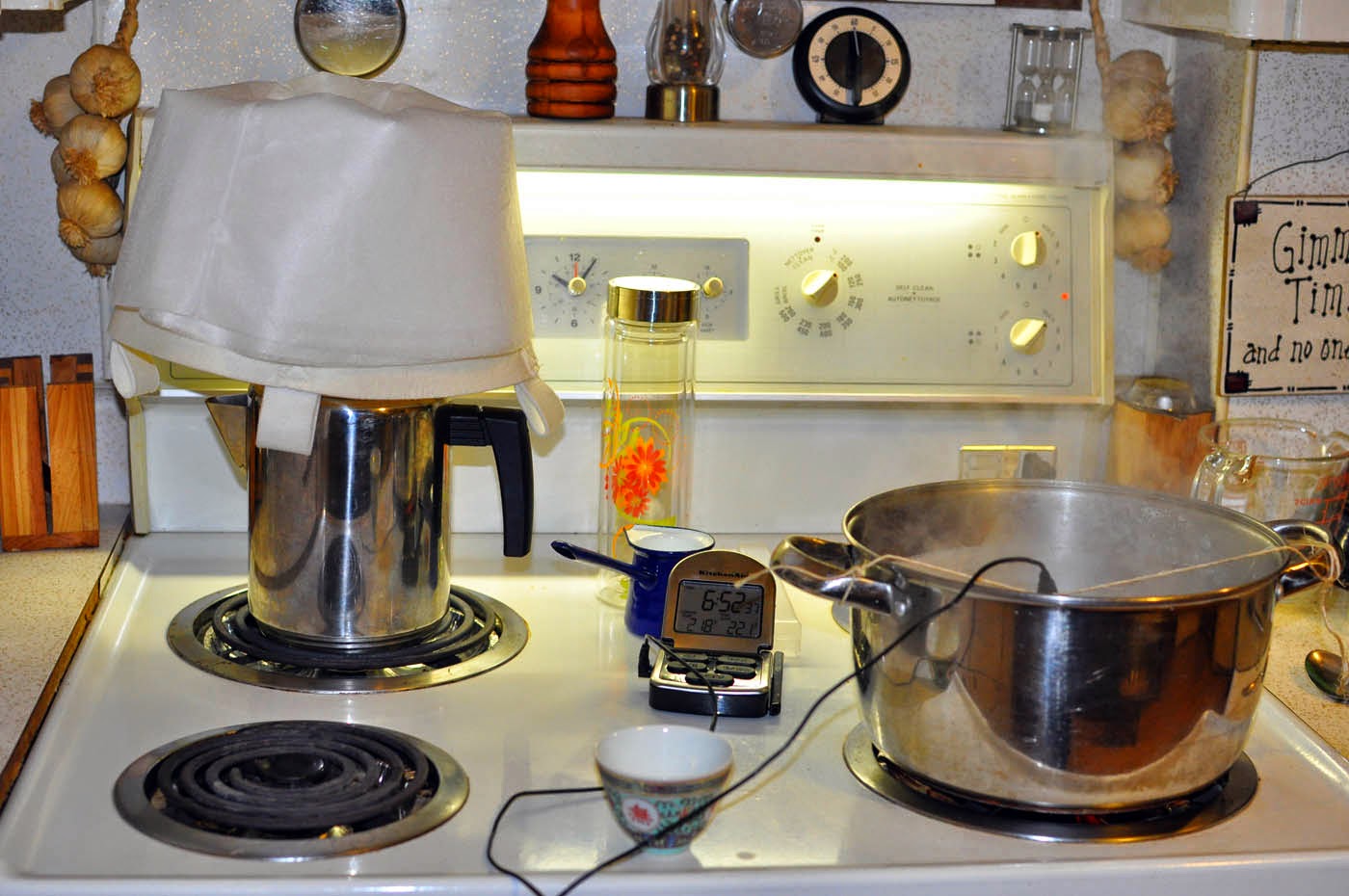Below is our log for our fourth week of sap collecting.
April 7 - 55 cups. Weather: High +15.6°C, low 0°C
April 8 - Rain storm. Dumped sap out. Weather: High +11.5°C, low +4.7°C
April 9 - No sap - didn't go below zero last night. Weather: High +10.9°C, low +2.2°C
April 10 - 104 cups. Weather: High +7°C, low -4.1°C
April 11 - 29.5 cups. Weather: High +13.4°C, low +2.9°C
The grand total for our next boil was 188.5 cups, or 11.78 gallons.
This is what the sap looks like at the start of the boil:
And this is what it looks like after five or six hours of boiling:
We boiled for 7 hours, and since we didn't get started until the afternoon it went into the evening. I ran an extension cord out to the sugar shack so we could put a lamp out there. It ended up being about midnight by the time we got it bottled.
To save money, Jeff and I have improvised on a lot of materials used for making maple syrup. The tall thin glass container in the center of the picture is a Bios tea infuser, bought at Canadian Tire for around $11.00. It is double-walled glass, and works perfectly as a hydrometer cup.
Since we make small batches of syrup each time, we have used our stainless steel coffee percolator to filter the syrup into. This makes for easy pouring into the funnel for the bottles.
The syrup is almost ready. It is supposed to be ready at 220°F, but I think our thermometer is not calibrated properly because when we brought it to 220 and tested it with the hydrometer, the syrup is not dense enough and has to be boiled longer. Through trial and error and a few hydrometer readings, we have found that when it reads 221 and starts to jump to 222 that it is done. For a properly calibrated thermometer however this would be over-done.
The minimum density for the syrup is 59.6 brix at 211°F. In the photo below the red line represents 59.6 brix. It has cooled a bit more in this photo, which makes it more dense. I have a chart that gives the brix reading according to certain temperatures and we like it a bit more than the minimum density. Below is the final hydrometer test and I'm satisfied it is now dense enough for bottling.
To ensure proper sterilization the syrup must be bottled at a temperature of no less than 180°F. I try to aim for 185°F. At about 190°F niter (or sugar sand) will re-form and the syrup will need to be filtered again so we want to make sure that doesn't happen. You lose a lot of syrup through the filtering process.
I put my bottles and coffee percolator in the oven at 200°F. That way when we transfer the syrup from the finishing pot to the percolator the temperature drop is minimized. The filtering takes some time however and the temperature will usually drop below 180°F. So once the filtering is complete, I put the percolator back in the oven with the thermometer in it and bring it back up to 185°F. Then I pour it into the bottles, and lay the bottles on their sides for a few minutes to sterilize the caps. This sterile bottling method means the syrup will keep for about a year if unopened. Once opened it will keep in the fridge for about six months.
Syrup that is not brought to the minimum density will spoil, and mold can form in the neck of the bottles where there is a small pocket of air. This can also happen if the syrup is not bottled in a sterile manner as described above. If the syrup is too dense, sugar crystallization will occur.
Below is is our produce from our fourth boil, 3 1/2 cups of syrup.
Below are samples of our syrup from our second, third and fourth boils. The syrup gets darker as the season progress.
The temperatures are remaining above zero quite often now so we're not sure if we will be having another boil. The sap goes "buddy" once the trees start to metabolize the sugar, which produces a very unpleasant bitter taste. Since we are new to this I don't know if we'll be able to smell or taste the "buddyness" in the sap.





















